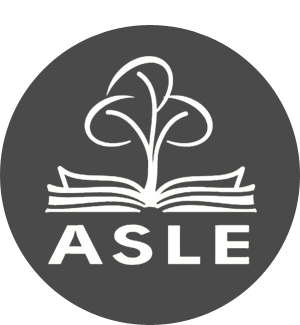 ASLE’s Scholar of the Month for December 2020 is Rebecca Oh.
ASLE’s Scholar of the Month for December 2020 is Rebecca Oh.
Rebecca Oh is Visiting Assistant Professor of English at the University of Illinois. Her research interrogates the intersections between postcolonial literature, environmental justice, politics, and the environmental humanities. Her scholarship has been published or is forthcoming in Interventions: International Journal of Postcolonial Studies, Modern Fiction Studies, ISLE and elsewhere.
How did you become interested in studying ecocriticism and/or the environmental humanities?
As a graduate student, I heard Ian Baucom give a talk on the Anthropocene. It was the most radical, fascinating idea I had come across, and I was immediately intrigued by the stunning challenges of temporal and spatial scale the Anthropocene poses. But as a postcolonial scholar I could not think about anthropogenic climate change outside the need to adjudicate historical responsibility and diagnose how environmental and climate harms are differentially distributed or experienced, falling most heavily on vulnerable countries in the global South as well as communities of color in the North. So, I was always inclined to put questions of environmental justice at the center of my environmental research and thinking. Reading Rob Nixon’s Slow Violence and the Environmentalism of the Poor was a real catalyst for me as it offered a vocabulary and a method for thinking about the uneven spatial and temporal scales of harm. It is also an excellent example of accessible yet rigorous scholarship, which I find to be more common in environmental humanities work than other fields. I think this really speaks to the spirit of interdisciplinarity that motivates so many of us; the problems we’re writing about are bigger than us or just our discipline.
Who is your favorite environmental artist, writer, or filmmaker? Or what is your favorite environmental text? Why?
This is a hard question. I enjoy teaching innovative nonfiction like Elizabeth Kolbert’s The Sixth Extinction or Naomi Oreskes and Erik M. Conway’s The Collapse of Western Civilization, especially in classes where we are practicing environmental writing. One of my favorite films to teach is Jennifer Baichwal and Edward Burtynsky’s Watermark. The way the documentary juxtaposes scenes of infrastructure, consumption, science, community, and pleasure forces us to think deeply about the interconnections between water and everything it touches. Students really take to the way it meshes the familiar and unfamiliar. The cinematography – especially the opening where it looks like you’re watching rock in free fall and then realize it’s flowing water – stuns me every time. Finally, Indra Sinha’s novel Animal’s People is a text I’ve thought a lot about and keep going back to read again and again. It portrays the Bhopal gas explosion of 1984 in such a provocative way – challenging Western readers and rejecting responses of victimization or pity while also clearly conveying the immense suffering and injustice that surround this event. It’s a great text to think with and to teach.
What are you currently working on?
Primarily I am working on completing my first book project. “States of Failure: Reading Promise, Provision, and Environmental Harm in the Global South” is about how postcolonial subjects live in environmental damage and what their practices of agency look like given the long-term, slow, and accretive quality of harms like oil pollution, toxicity, and rising seas. When there are no solutions, what actions can be taken and indeed how can we think about the productivity of actions that are far from achieving their goals? These questions build on a long tradition of theorizing weak agency in postcolonial studies. They have led me to think about failure, especially the failure of postcolonial states to address environmental harm and the failure of postcolonial citizens to induce systemic change, as important cultural forces. I look at how failure mediates the way states are imagined and experienced by those who have little cause to be invested in them, and yet still are. I attend to how failure becomes a tool for engaging with the state, for holding it accountable, and for envisioning better polities and forms of provision or care across literature, legislation, and popular writing.
My current work on living in environmental damage has also led me to begin formulating ideas for a second project on apocalyptic realism in postcolonial, Black, Latinx, and Indigenous literature. My interest here grows from the question “apocalypse for whom?” as well as recent debates in world literature that insist on the plurality of worlds. I am interested in how cultural production from the standpoints of those historically rendered futureless by institutions like colonialism, racism, and capitalism defamiliarizes and redefines our understanding of apocalypse. Rather than a future event that will end the world and time, histories of apocalypse insist that the end of the world has already arrived. Apocalypse thus becomes available to realism; it most approximates the referential historical experience of being made futureless. I am working on a related piece for a collection provisionally titled Days of Futures Past, edited by Kate Polak and Ian MacDonald. Finally, I’ve just put together a panel on climate change, realism, and its antinomies for ACLA 2021. We’ve got a fantastic lineup!
What is something you are reading right now (environmental humanities-related or otherwise) that inspires you, either personally or professionally? Comment briefly on why or how it inspires you.
I love the collection Arts of Living on a Damaged Planet, edited by Anna Tsing, Heather Anne Swanson, Elaine Gan, and Nils Bubandt. I find the creative and collaborative aspect of this book very inspiring; it’s certainly a different mode from writing a literary monograph. I especially appreciate the way the editors and authors all attend simultaneously to destruction and creation, looking for hope in unexpected places and indeed offering pictures of hope that are complex and sometimes dark. Rebecca Solnit’s A Paradise Built in Hell is similar – I’m late to the Solnit fanclub. It’s easy to be seduced into pessimism by the complexity of social and environmental problems we are facing. But these works underscore the optimism that is available within even the most damaged of circumstances. Finally, I’ve just started Jessica Hurley’s Infrastructures of Apocalypse. I enjoy work that turns the familiar upside down to look up from below, and Hurley does this for apocalypse. We’re both asking questions about what seemingly negative concepts – like apocalypse and failure – do in the world, how they are used in both good and bad ways.
Is there a scholar in the field who inspires you? Why?
Ursula Heise’s work is incredible. She has revolutionized the field in so many ways. In her latest work Imagining Extinction, I admire the brilliant and detailed way she shows us that extinction is a cultural process and idea. I am also deeply interested in methodological innovations, and Heise offers at least one in every book. In my own work I’ve taken to thinking about the archives of long-term environmental harm through an intertextual reading practice that treats literature and legal or political documents as intertexts. Heise is one of the few other scholars I’ve found willing to ask what a humanities perspective can help us understand about a legal ruling. She’s also an incredibly incisive yet clear writer and a generous person. Even as a scholar of her stature, she agreed to have coffee with me after I cold-emailed her before our last in-person ASLE conference. I must also shine a grateful light on Cajetan Iheka and Tess Shewry who, in addition to being fantastic scholars, read my work after meeting me once and have steadfastly supported my writing. They offer a model of supportive and unstinting mentorship that is truly inspiring, one I will be forever paying forward.
